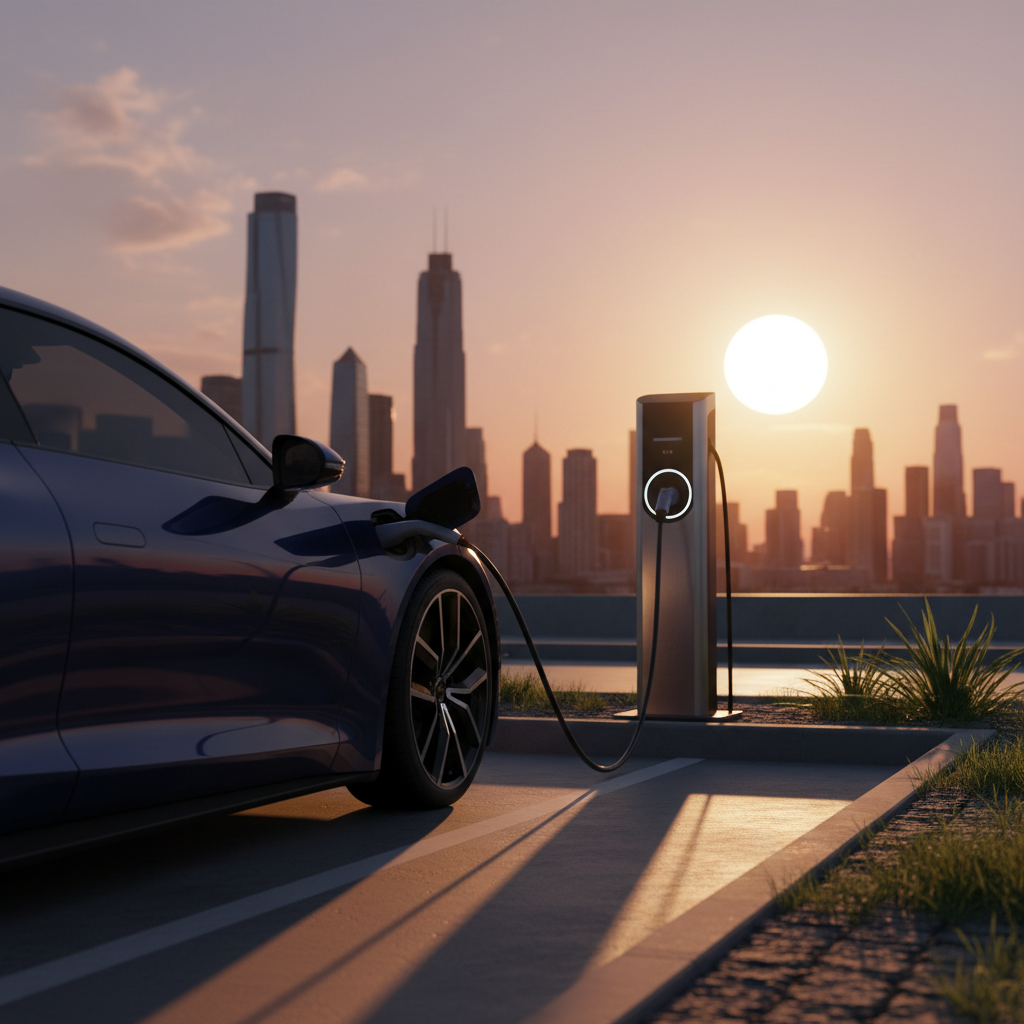
Table of Contents
Introduction
The rise of electric vehicles (EVs) presents a revolution in how we think about transportation, fueling not only a shift towards sustainability but also new considerations for protecting these advanced automobiles. With the growing number of EV owners on the road, understanding the nuances of insurance tailored specifically for electric vehicles has never been more important. Are you prepared to navigate the distinctive insurance landscape that comes with owning an EV? This guide will illuminate the vital aspects of electric vehicle insurance you need to know to safeguard your investment and enjoy peace of mind.
Electric vehicles are rapidly transforming the automotive market, accounting for an increasing share of new car sales globally. As EV technology advances and adoption expands, insurance providers are evolving their offerings to address the unique risks these vehicles pose. Unlike traditional internal combustion engine cars, electric vehicles come with specialized components, such as batteries and electric drivetrains, that demand specific coverage considerations. According to recent market reports, the global electric vehicle insurance market is projected to grow substantially within the next decade, reflecting the importance of these specialized insurance products for consumers and insurers alike.
For many prospective and current EV owners, concerns about repair costs, battery replacements, and the safety of charging infrastructure often dominate their thoughts. Traditional auto insurance policies may not fully address these aspects, leading to uncertainty about adequate protection. It’s common to wonder whether coverage includes the costly battery pack or covers electric-specific accessories, such as home EV chargers. Recognizing these questions is the first step towards making informed decisions to shield yourself financially from unexpected costs.
If you are transitioning from a gasoline vehicle or purchasing your first EV, understanding the distinctions in insurance policies is crucial. You want assurance that your coverage matches not just the value of your car but also the potential liabilities and risks unique to electric vehicles. Navigating this terrain effectively empowers you to benefit from comprehensive protection while potentially optimizing your insurance premiums through specialized EV programs offered by some insurers. For foundational knowledge about insurance and how it works broadly, you might find it helpful to start with an insurance basics primer to set the groundwork before diving into EV specifics.
What You’ll Learn in This Guide
This comprehensive guide is designed to equip you with essential insights about electric vehicle insurance. From understanding coverage options to managing costs and maximizing benefits, we’ve got you covered.
- Coverage Essentials: Gain clarity on the typical insurance components tailored to EVs, including liability, collision, comprehensive, and specialized coverage for batteries and charging equipment.
- Cost Factors: Learn the key elements that influence your insurance premiums, such as your EV’s make and model, the replacement cost of batteries, driving location, and usage patterns.
- Benefits of Proper Insurance: Discover why customized EV insurance brings added financial protection and peace of mind, safeguarding you against high repair costs and unique risks.
- Choosing and Saving on Insurance: Get actionable guidance on selecting the right policy for your needs and practical tips to lower your premiums without compromising essential coverage.
As you move forward, this guide will break down these elements into manageable sections, giving you a thorough understanding of EV insurance. We’ll explain the components of EV coverage, discuss how insurers price these policies, and share insights on the advantages of securing tailored protection. You’ll also find expert advice on navigating quotes, discerning policy details, and leveraging discounts. Equipped with this knowledge, you’ll be confident in making smart choices that align with your driving habits and financial goals.
In the sections that follow, we’ll take a deep dive into what insurance for electric vehicles covers and explore the specific protections vital to EV owners. We’ll outline the factors that can affect your insurance costs and highlight strategies that can help you reduce your premiums while maintaining comprehensive coverage. Understanding the major benefits of properly insuring your EV will underscore why this step is crucial for your vehicle’s longevity and your peace of mind.
Whether you’re new to electric vehicles or looking to optimize your current insurance, the insights provided here will prepare you to engage confidently with insurers and make the best decisions. Let’s embark on this journey together to ensure your electric vehicle is well protected and that you maximize the value of your insurance investment.

As electric vehicles (EVs) become increasingly prevalent, understanding the nuances of insurance specifically designed for these advanced automobiles is essential. Unlike traditional vehicles, EVs come with unique components, such as high-capacity batteries and charging systems, which require tailored insurance solutions. This discussion will delve deeper into what EV insurance typically covers and the major factors influencing costs, equipping you with knowledge to make informed decisions. By exploring these critical areas, you will appreciate the importance of securing the right insurance to protect your investment and enjoy peace of mind during your EV ownership journey.
Comprehensive Coverage Components in Electric Vehicle Insurance
Electric vehicle insurance extends beyond standard auto policies to account for the specific needs and risks associated with EVs. Many policies include traditional coverage types like liability, collision, and comprehensive protection, but enhanced options tailored to EVs distinguish them from basic auto insurance. For instance, coverage for the battery and electric-specific parts is essential given the high replacement costs and specialized repairs involved. Understanding these components helps EV owners avoid unexpected expenses while ensuring their vehicle remains protected from a range of hazards. To fully grasp this concept, it helps to understand auto insurance coverage essentials, which lay the groundwork for how EV insurance policies are structured.
Moreover, additional protections targeting EV-specific risks, such as charging station damage or battery degradation, are increasingly being incorporated by insurers to provide comprehensive peace of mind. Roadside assistance designed for electric vehicles is another distinct feature, equipped to handle challenges like dead batteries or charging failures, unlike standard towing services. These specialized features highlight how EV insurance adapts to the vehicle’s advanced technology and usage patterns, ensuring tailored protection that aligns with the owner’s specific needs.
Key Aspects of EV Insurance Coverage
To better understand what makes electric vehicle insurance unique, consider these key coverage elements often offered:
- Liability Coverage: This remains fundamental for EV insurance, covering costs for bodily injury and property damage to others if you are at fault in an accident. Given EVs’ comparable presence on the roads, liability is critical for financial protection.
- Collision Coverage: Covers damage to your EV resulting from accidents, whether involving other vehicles or single-car incidents. This is essential due to the potentially high repair costs associated with EV components.
- Comprehensive Coverage: Protects against non-collision-related damages such as theft, vandalism, fire, or natural disasters. This safeguard is particularly important for costly EV batteries and electronics.
- Battery and Electric-Specific Parts Coverage: Many EV policies now offer dedicated coverage for batteries and parts unique to electric propulsion. This inclusion addresses replacement costs, which can be a significant portion of repair expenses.
- Roadside Assistance: Specialized services for EVs, such as providing emergency charging when stranded, distinguish this coverage from traditional roadside assistance. It ensures help tailored to EV-specific breakdowns beyond conventional towing.
Influencing Factors and Cost Management in EV Insurance
Understanding what drives the cost of insurance for electric vehicles helps owners make strategic choices when selecting coverage. Premiums are influenced by numerous factors, some shared with traditional vehicles and others unique to EV ownership. Variables such as the vehicle’s make, model, and battery size significantly impact premiums due to differing repair and replacement costs. The geographical location also plays a vital role, reflecting regional accident rates, theft prevalence, and local regulations. To deepen your understanding of how insurance costs are assessed, reviewing the insurance underwriting process can provide valuable insights.
Additionally, insurers increasingly recognize the benefits of incentivizing safe and environmentally friendly driving habits, offering discounts that can offset the typically higher premiums associated with EVs. By leveraging these potential savings and thoroughly comparing quotes from different providers, you can optimize your insurance portfolio for both coverage and cost-effectiveness. Employing knowledge of discount programs and coverage customization is key to balancing financial prudence with comprehensive protection.
Important Considerations for EV Insurance Costs
Several pivotal factors should be considered to fully understand your insurance expenses and available savings opportunities:
- Vehicle Make and Model: Premiums vary based on the specific EV model, reflecting repair complexity and parts costs. Luxury or high-performance EVs often incur higher rates compared to more economical models.
- Battery Cost and Replacement: Since batteries are among the most expensive EV components, their replacement or repair heavily influences insurance costs. Policies that include battery-specific coverage may affect premium pricing.
- Driver’s Location and History: Accident rates, theft statistics, and local legislation in your area impact premiums. Furthermore, your personal driving record remains a significant determinant in risk assessment.
- Usage Patterns: How and where you drive—such as urban stop-and-go traffic versus highway cruising—affects the likelihood of claims and, consequently, the insurance premium.
- Coverage Limits and Deductibles: Higher coverage limits increase premiums, whereas choosing higher deductibles can reduce upfront costs, allowing you to tailor the plan according to your risk tolerance.

Conclusion
As electric vehicles continue to reshape the automotive landscape, securing the right insurance coverage tailored to these innovative cars is essential for protecting your investment and ensuring peace of mind. This guide has unpacked the unique aspects of electric vehicle insurance, including specialized coverage components such as liability, collision, comprehensive protection, and crucially, coverage for the expensive battery and electric-specific parts. We’ve also explored additional protections like coverage for charging stations and EV accessories which highlight how tailored insurance products are evolving alongside growing electric vehicle adoption.
Understanding the factors that influence the cost of insuring an electric vehicle empowers you to make informed decisions. Premiums are shaped by your EV’s make and model, battery replacement costs, your driving habits, and coverage limits chosen. We also discussed potential discounts available exclusively for EV owners from safe driver incentives to bundling options, all designed to help you optimize your insurance expenses without sacrificing necessary protection. These insights aim to guide you toward a comprehensive and cost-effective insurance policy that fits your specific needs.
Properly insuring your electric vehicle delivers significant benefits beyond just compliance with legal requirements. You gain financial coverage against potentially high repair expenses specific to EV technology, support for charging infrastructure damage, and services like roadside assistance tailored for electric powertrains. By selecting an insurance provider well-versed in EVs, you can leverage added benefits and enhanced service that ensure a smooth claims process in case of incidents involving your vehicle.
For actionable next steps, begin by reviewing your coverage needs carefully based on your EV’s particular features and your driving patterns. Comparing quotes from multiple insurers familiar with electric vehicles allows you to find competitive pricing and better terms suited to your lifestyle. Pay close attention to policy exclusions and conditions to avoid coverage gaps. Additionally, understanding insurance deductibles can help you balance monthly premiums with out-of-pocket expenses when claims arise. For a foundational insurance overview, you might want to explore our insurance basics guide and learn about auto insurance coverage essentials to deepen your insight. When it comes time to file a claim, familiarity with the insurance claims process is invaluable, helping you navigate smoothly and efficiently.
In closing, protecting your electric vehicle with the right insurance policy is an investment not just in your car, but in your peace of mind and financial security. Staying informed about the evolving insurance offerings for electric vehicles ensures you can adapt and benefit from innovations in coverage and discounts. By taking a proactive approach to choosing and managing your EV insurance, you safeguard against unexpected costs and enjoy the full advantages of your sustainable transportation choice. For further enrichment, continue exploring related insurance topics and stay updated on the latest industry developments tailored to your needs.
